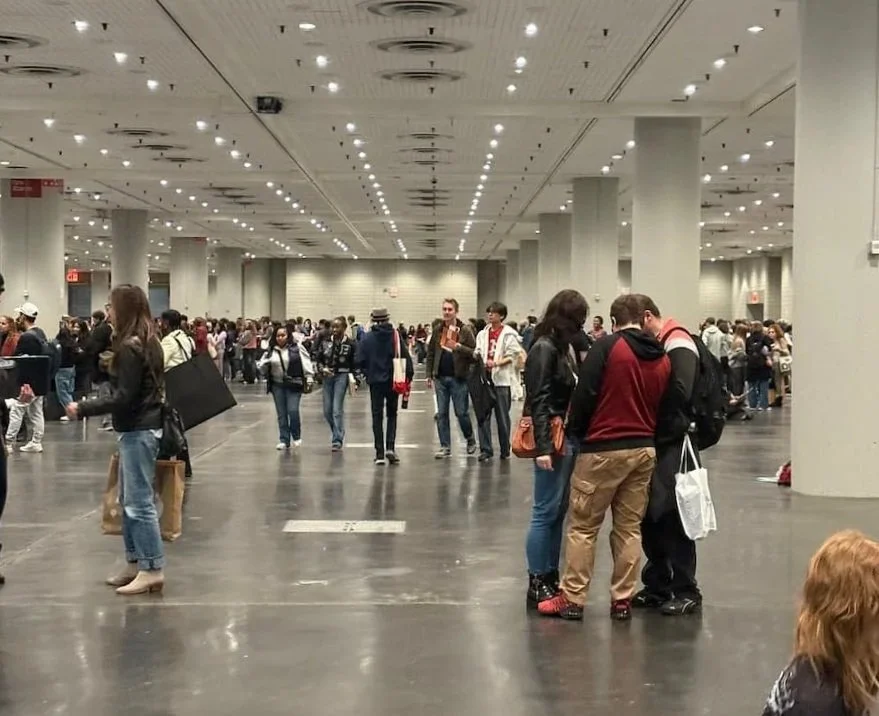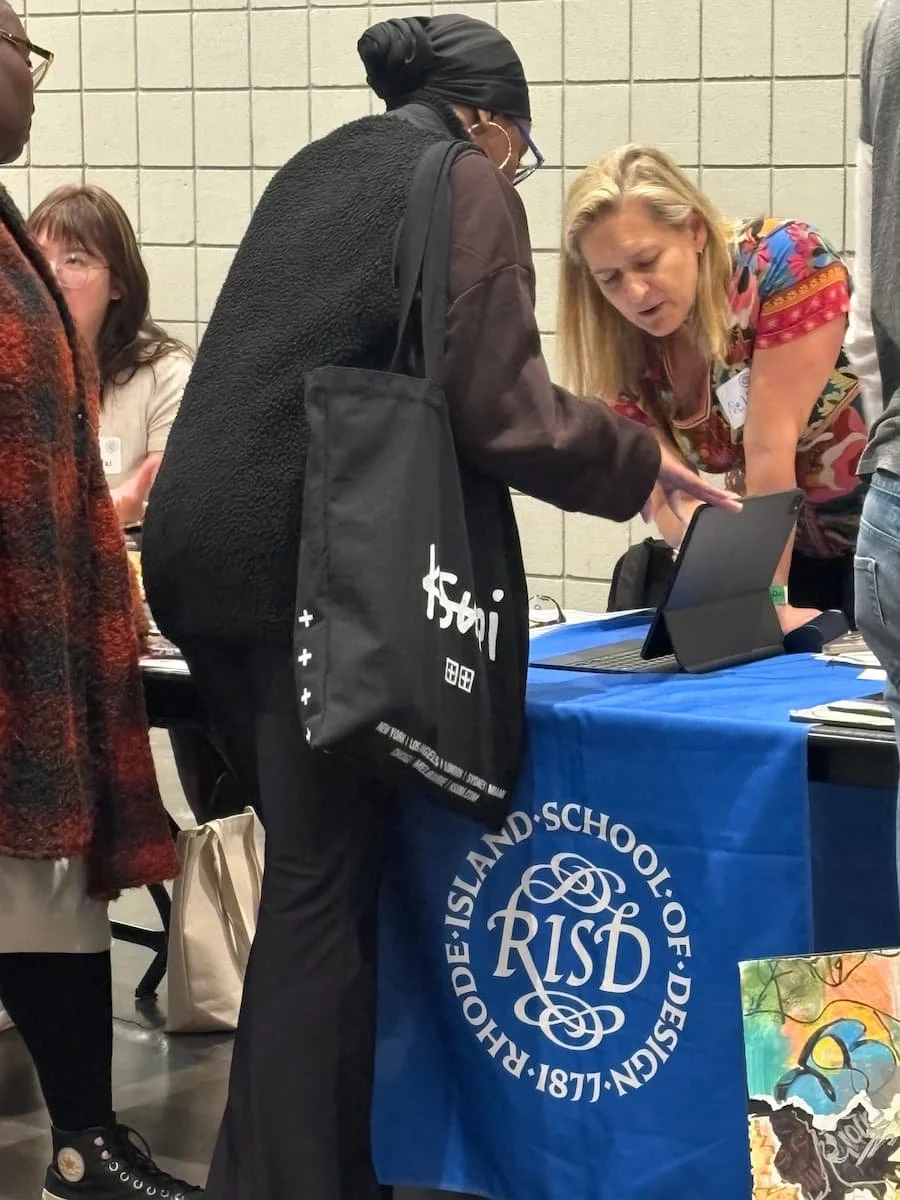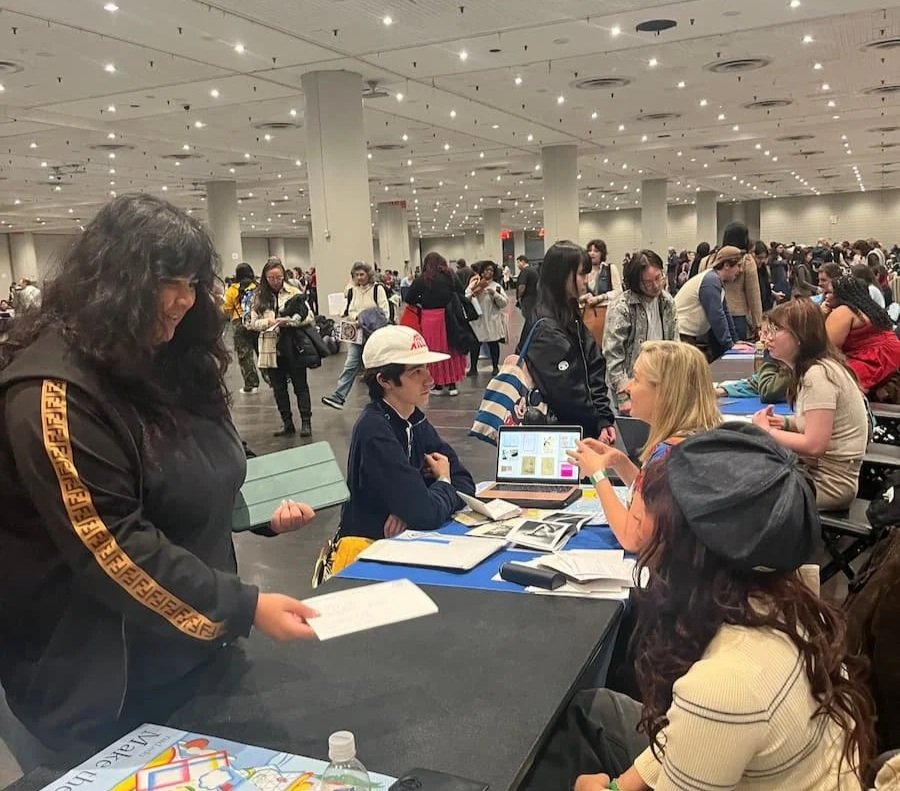RISD Portfolio Requirements: What I Learned Reviewing Portfolios at the RISD Booth at National Portfolio Day
The Javits Center was already buzzing when I arrived for National Portfolio Day in New York. Students were streaming through the doors carrying sketchbooks, oversized portfolios, iPads, boxes of charcoal, and that particular combination of nerves and hope that is unmistakable. Inside the convention hall, hundreds of tables stretched out under bright industrial lighting, and each one seemed to attract its own small crowd.
Javits Center, NYC
Crowd of students at National Portfolio Day in New York preparing for portfolio reviews
This year, I had the honor of being invited to join the Rhode Island School of Design’s team. The long RISD banner proudly stretched across the table in front of me. To my left and right were faculty, alumni, and admissions reviewers, each deep in conversation with students eager to understand what RISD truly looks for. It was a privilege to sit among them, take part in the reviews, and spend hours looking through students’ work.
Standing on the RISD side of the table changed everything about how I talk with students about the RISD portfolio requirements. Nothing teaches you more quickly or clearly than seeing hundreds of portfolios in a single day. Patterns emerge. Strengths repeat. Weaknesses repeat. And it becomes immediately clear what RISD responds to and what simply does not meet the level of an accepted RISD portfolio.
RISD booth at the National Portfolio Day NYC 2025
The RISD booth at National Portfolio Day, where hundreds of students sought feedback on their portfolios.
Below are the insights I took away from the event, shared so students and families can enter this process with clarity, confidence, and a strong understanding of how to build a compelling portfolio for RISD or any top art and design program.
What RISD Portfolio Requirements Really Mean When You’re Standing Behind the Table
RISD requires applicants to submit 12 to 20 recent works that demonstrate a range of ideas, media, and approaches. This is the formal guideline. What matters more deeply is what those pieces reveal about how you think, how you observe, how you make decisions, and how you respond to materials.
Student presenting artwork
during a portfolio review at National Portfolio Day
Recent Work Carries the Greatest Weight
RISD looks closely at your most recent work because it reflects your current engagement, skills, and curiosity. Older pieces may be included for context, but they will not carry the portfolio.
Finished Pieces and Sketch Form Work Should Appear Together
A strong portfolio for RISD shows both finished work and what RISD calls research or preparatory work. Sketch form pieces, exploratory studies, and developmental experiments reveal your thinking, not just your execution. I reviewed countless portfolios where students had beautiful final drawings but nothing that showed how they arrived there. RISD wants both.
Direct Observation Matters More Than You Think
Drawing from observation is one of the clearest indicators of visual intelligence. RISD reviewers respond to work grounded in what you see, not what you imagine or copy. Many students see direct observation as basic. In reality, it is often the strongest indicator of readiness.
Conceptual Thinking Is Not Optional
Technical skill alone does not make a RISD art portfolio competitive. RISD evaluates your ability to generate ideas, make connections, explore themes, and push into less predictable territory. Conceptual thinking appears in how you choose compositions, how you use materials, and how your ideas evolve across pieces.
The Most Common Issues I Saw in Portfolios Applying to RISD
Over the course of the day, the same patterns repeated. These issues do not make a student untalented. They simply indicate where growth is needed in order to meet the level of an accepted RISD portfolio.
Over-Focus on Hyper-Realistic Rendering
Many students believe RISD wants hyper-detailed realism. This leads them to spend hundreds of hours making something look like a photograph. RISD wants to see how you think, not whether you can duplicate an image.
Weak Composition and Centered Imagery
One of the most striking issues was how often students placed their subject directly in the middle of the page without considering background, negative space, or compositional tension. This reads as immature work. Thoughtful composition is part of conceptual thinking.
Little to No Experimentation
RISD values experimentation because it shows courage, curiosity, and willingness to participate in learning. I saw many portfolios where every piece was polished, but none took risks. A RISD portfolio review looks for willingness to try new materials and approaches.
Derivative Work or Anime Replication
Copying photos or mimicking existing styles does not demonstrate creativity, originality, or authorship. RISD reviewers look immediately for work that comes from you rather than from a trend.
Missing Process Documentation
A lack of process documentation hurts students more than they realize. RISD wants to see both the making and the thinking, and process work is the bridge. You can learn more about effective process documentation in our guide on how to document your art process.
What Students Said When Asked About Their Feedback
Across the day, I asked students what they had been hearing from reviewers. The themes were consistent.
“My work didn’t have clear concepts.”
“I didn’t have much process documentation.”
“My artwork wasn’t experimental enough.”
“I didn’t take enough risks.”
“My pieces didn’t show enough variety.”
These are precisely the areas where RISD portfolio requirements are most strongly felt. Students sense it immediately when they sit across from a reviewer.
What RISD Reviewers Want to See in an Accepted RISD Portfolio
Evidence of Thinking and Making Together
RISD is known for valuing the relationship between thinking and making. Accepted portfolios show an artist who moves fluidly between ideas, materials, and decisions. Students can strengthen their ability to build a cohesive visual story by reading our guide on how to develop a cohesive portfolio narrative.
Breadth and Depth
RISD wants to see a full range of your ideas across drawing, painting, mixed media, photography, digital work, or sculpture. You do not need every medium, but you need to show both technical range and conceptual depth.
Closeup of student portfolio
showing preparatory sketches and finished artwork
Balance Between Assigned Projects and Self-Directed Exploration
Assigned projects reveal how you respond to parameters. Self-directed exploration reveals who you are as an artist. Both matter.
Curiosity, Risk, and Experimentation
Students who experiment with materials, compositions, and ideas demonstrate the intellectual courage RISD values.
Strength That Can Lead to Scholarships
Although RISD does not award scholarships purely on the portfolio, the strength of your work influences merit decisions across many art and design schools. Portfolios that meet RISD’s level of conceptual rigor often lead to scholarships to art schools broadly.
How to Present Your Art for RISD Even Before Senior Year
The single piece of advice I repeat most is this: Do not wait until Senior year. By then, your timeline is too compressed to make meaningful changes before deadlines.
Start Refining Your Work in 10th and 11th Grade
Portfolio development is a long, iterative process. Starting early allows your skills and ideas to mature organically.
Photograph Your Work Thoughtfully
The presentation matters. Clear lighting, neutral backgrounds, and consistent framing help reviewers focus on your decisions, not on distracting elements.
Show Evidence of Process
Sketches, experiments, and research or preparatory work reveal how you develop an idea. RISD pays close attention to this.
Create a Sequenced Story
Your portfolio should have a beginning, a middle, and a sense of progression. This sequencing shows how you think.
If You Want Your Portfolio for RISD to Stand Out
If you want your child’s portfolio to grow in both technical and conceptual ways, working with an experienced reviewer can accelerate that process. I work with students in grades 9 through 12, helping them build portfolios that reflect their strongest ideas and most ambitious thinking.
“Dr. Daniel believed in me and my potential when I didn’t. She helped me every step of the way to develop my art and get into Cooper-Union.”
If you want your child to enter the process with clarity and a strong creative foundation, reach out for a complementary introductory conversation.
-
RISD requires 12 to 20 recent works. Quality and conceptual depth matter more than quantity.
-
No. RISD strongly recommends including finished work alongside research or preparatory work to show your thinking.
-
Yes. RISD values observational drawing because it demonstrates visual intelligence and decision making.
-
Yes. RISD accepts all media including digital art, photography, video, and graphic design.
-
Yes. Strong portfolios balance assigned projects with self-directed exploration.
-
Yes. Derivative work does not meet RISD’s standards for originality or conceptual thinking.
-
Starting in 10th or 11th grade gives students time to develop meaningful ideas and strengthen technical foundations.
-
While RISD evaluates scholarship eligibility separately, strong conceptual portfolios often influence scholarship decisions at many art schools.
After spending the day at the RISD booth and talking with so many young artists, I was reminded of how much potential students already carry and how powerfully that potential grows when they understand what schools are actually looking for. A portfolio is not just a collection of pieces. It is a record of your thinking, your risks, your curiosity, and the direction you’re moving as an individual and an artist. When students have the right guidance early enough, the entire application process becomes clearer, more intentional, and far more rewarding.
This article is part of our series on essays and statements for art applicants. You may also want to read Personal Statement for Art School: Examples & Guide and Scholarships for Art School: Guide to Financial Aid and Merit Awards.



